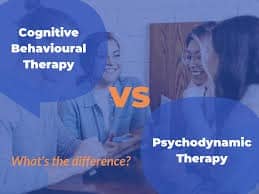In the US, one in five adults grappling with mental illness, with half of all cases surfacing by age 18. While depression rates might differ, both nations share a concerning trend: 75% of mental health conditions manifest by age 24, highlighting the critical need for early intervention and improved access to care in both countries. Various therapies solve mental health conditions. However, here we will discuss two prominent therapies: Psychodynamic therapy and cognitive behavioral therapy.
Psychodynamic Therapy is rooted in Freudian principles and delves into the unconscious process of the person’s mind related to past trauma. On the other hand, Cognitive Behavioral Therapy focuses on current thoughts, feelings, and behaviors, which they have to modify for a better life for a person. In this blog, let’s understand in detail both therapies and the difference between psychodynamic therapy vs CBT.
What is cognitive behavioral therapy?

Cognitive behavioral therapy is a psychological therapy that solves a range of problems, such as depression, alcohol, anxiety disorders, drug use problems, and various problems. CBT focuses on solving your present-day problems instead of finding the root cause of the problem. The duration of treatment is short-term and lasts for 2 to 3 months. It is helpful in conditions such as Anxiety disorders, Depression, Eating disorders, and Insomnia.
It is based on core principles such as follows:
- Psychological problems arise due to unhelpful ways of thinking.
- Psychological problems are based on learned patterns of unhelpful behavior
- Patients suffering from psychological problems can learn better ways of coping with CBT by relieving their symptoms.
How does CBT work?
The concept of CBT is that thoughts, feelings, physical sensations, and actions are interconnected. When a person has negative thoughts and feelings, they get trapped in a negative cycle. CBT helps a person deal with problems positively by dividing them into smaller parts. Also, CBT helps you deal with current problems instead of past issues.
Key Features of CBT
CBT helps a person to think positively in the current situation without thinking of past situations. Let’s know the Key Features of CBT.
- An agenda is set for each session of CBT so any issues don’t arise what to do and discuss
- It focuses on the present situation rather than the past.
- Homework is an essential element of CBT
- Duration of treatment is short and brief
- Collaborative in nature because the patient and the therapist work together to achieve goals.
Pros of cognitive behavioral therapy
- The duration of CBT is short compared with other talking therapies.
- It is a highly structured therapy that is provided in different formats, such as self-help books, groups, and online.
- Based on a person’s capacity to change themselves in the form of thoughts, feelings, and behaviors, a person changes themselves.
- Cognitive behavioral therapy provides you with valuable and practical strategies that you can use in everyday life after the treatment is complete.
- The treatment is as effective as medicine in solving mental health problems. Also, it is helpful in cases where medicine alone doesn’t work.
- It is collaborative therapy where the patient and the therapist come together to achieve the goal.
Cons of cognitive behavioral therapy
- You need to commit yourself to the process of therapy to get the benefits of CBT.
- You need to attend regular CBT sessions and take out extra time after the session for homework completion.
- The CBT is not suitable for people with more complex mental health issues or a person who faces issues in learning.
- You need to confront your emotions and anxieties in front of therapies, due to which you experience anxiety or discomfort in the initial period of sessions.
- CBT does not solve any broader problems that have a significant impact on someone’s health and well-being.
What is psychodynamic psychotherapy?

Psychodynamic Therapy is talk therapy. It is a therapy that involves uncovering the subconscious, identifying patterns, and finding relief. It is a therapy where patients talk about their problems with a therapist openly. The therapy focuses on solving past trauma of the patients so the current situation can be better. The success of these therapies depends on the relationship between the patient and therapist. Psychodynamic Therapy teaches coping skills to patients, which protect patients against relapse in the future after therapy. Also, it is a long-term therapy.
How does psychodynamic talk therapy work?
Psychodynamic therapy is based on the following principles:
- Unconscious motivations – such as biology, social pressure, and psychology that affect a person’s behavior.
- Experience shapes the personality of a person.
- Past experiences affect the present.
- When there is a development of insight into thoughts and emotions, it helps individuals address psychological issues.
- Expanding your range of choices and improving personal relationships help patients address their problems.
- When a patient becomes free from the past, it helps them live a beautiful life in the future.
In psychodynamic therapy, the relationship between the therapist and the patient plays an important role. Only then will the patient open up and talk freely about their past events and feelings. Also, a therapist will be able to understand how patients see the world and behave. As a result, therapy is provided where patients develop themselves, change their behavior, and live a beautiful life.
Techniques used by psychodynamic therapists
The technique helps address specific issues. The issues such as mental health issues, emotional issues, and negative thought patterns. Let’s know the Techniques used by psychodynamic therapists.
- free association
- Recognizing resistance.
- Noticing transference – The transfer of feelings for a person or event in the past or the present.
- counter-transference
- Catharsis refers to the place where there is an intense emotional release.
Key Features of Psychodynamic Psychotherapy
- Focus on your personal history.
- It is less structured and without homework assignments.
- The therapy is long-term, from a few months to years
- The relationship between the client and the therapist is also a focus of the therapy
- The patients set the agenda for the session to talk about things going on in their minds.
Pros of Psychodynamic Psychotherapy
Psychodynamic psychotherapy offers a multi-approach to mental health that encompasses various pros such as follows:
- Psychodynamic Psychotherapy defines the root causes of psychological issues and the complexity of human behavior.
- The therapist taught coping skills, which protect patients against a relapse in the future after therapy.
- Psychodynamic Psychotherapy is a versatile therapy that is used to treat various problems like anxiety, depression, eating disorders, and substance abuse conditions.
- The benefits of therapy increase over time
- The therapist provides a supportive environment for patients to discuss past traumas so they can speak their minds. Also, provides practical solutions.
Cons of Psychodynamic Psychotherapy
- Psychodynamic Psychotherapy is less structured than CBT
- A longer-term commitment is required as it is expensive because of the length of therapy.
- In this therapy, the person needs to discuss childhood trauma and personal history, which a person may not wish to do.
- It is essential to check the therapist’s qualifications and knowledge for this therapy.
Psychodynamic psychotherapy vs CBT
The ways you can understand the differences between psychodynamic therapy vs CBT so you choose the right therapy for yourself.

- Psychodynamic therapy is open-ended, and it’s a long-term therapy. CBT is contracted and short-term therapy.
- Psychodynamic therapy delves deep into past issues to solve present problems. CBT focuses on present problems and solutions.
- Psychodynamic therapy states that your past events define your current issues. CBT says that your current thoughts affect your interpersonal behavior or create other mental health issues.
- Psychodynamic therapy is primarily client-led. In contrast, CBT is primarily therapist-led and is oftentimes more structured as a result.
- Psychodynamic therapy is session-based; all things take place during therapy. CBT takes place during sessions but assigns patients to work on skills after the session.
- Psychodynamic therapy focuses on long-term client-therapist relations, especially for problem-solving. CBT focuses on the individual so that a patient can switch between multiple therapists during the therapy.
This is the main difference between psychodynamic therapy vs CBT. Based on this difference, you can make a decision about which therapy to adopt.
FAQs: Psychodynamic therapy vs CBT
Which therapy is right for me: psychodynamic therapy vs CBT?
The therapy that is right for you depends on your individual needs. Also, the therapy that benefits you in mental health conditions such as disorder, mental illness, or trauma that is right for you.
How are psychodynamic therapy and CBT therapy similar?
The similarity between therapies is that Both therapies are talk-based therapy. Also, it
assumes what goes on inside the patient’s head that influences their behavior. Additionally, changes are brought about by converting the unconscious into conscious awareness, and both have goals of increasing personal and interpersonal functions.
Is psychodynamic therapy vs CBT which is more effective?
According to the Journal of Consulting and Clinical Psychology, psychodynamic therapy can be at least as efficacious as CBT for depression.
Conclusion
Psychodynamic Therapy delves into unconscious processes and focuses on the past trauma of patients, and it aims to solve long-term change. On the other hand, CBT focuses on identifying negative thought patterns and behaviors and trying to change them for a better current life. Both therapy have their pros and cons, and the choice of therapy depends on individual specific therapy goals.
At Calusa, we’ve crafted an intensive outpatient program to simplify the path toward enduring mental wellness. This program seeks to tackle the root causes of distress, impart new coping skills, foster equilibrium and healing across the mind, body, and spirit, and empower individuals with a sense of passion and purpose.










